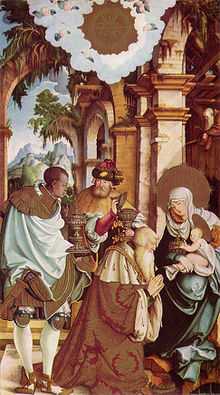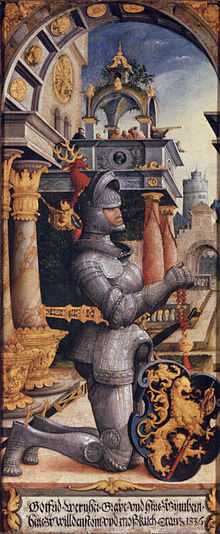Master of Meßkirch

The Master of Meßkirch (German: Meister von Meßkirch; active c. 1515 - 1540) was an anonymous German Renaissance painter.
Biography
The so-called Master of Meßkirch is named after the eleven altarpieces (one main altarpiece and ten auxiliary ones) he painted for the Stiftskirche St. Martin in Meßkirch between 1536 and 1540. His birthplace and apprenticeship are unknown, but a majority of scholars believe that he studied under an artist from the circle of Albrecht Dürer. Hans von Kulmbach and Hans Leonhard Schäufelein are especially likely candidates.[1] His work also resembles that of the Ulm school, so it is possible that he received training there. From the 1530s onwards his works seem to display familiarity with contemporary northern Italian painting. Hans Baldung Grien was also influential to his work.[1]

Early on he worked for Count Eitel Friedrich III of Hohenzollern in Veringenstadt. Later he was called to Meßkirch to work for Count Gottfried Werner von Zimmern.
Throughout the master's career his figures had Manneristic proportions. While early on his colors were bright and iridescent, his coloration became calmer and more muted in his last years.[1]
His most important works include:
- The Falkenstein Altarpiece (1525)
- Frescoes from the choir of the Cistercian abbey in Heiligkreuztal (1532–35)
- The altarpieces for Stiftskirche von St. Martin, from which more than 40 panels have been separated and are held in the collections of European and American museums.
Identity
Art historical research has not yet succeeded in identifying the Master of Meßkirch. The proposed assignations of his oeuvre to the painters Jörg and/or Jerg Ziegler, Wilhelm Ziegler, or Marx Weiß are now rejected by a majority of scholars. On the other hand, the painter Peter Strüb the Younger seems ever more likely. He is recorded as an active and successful painter in Veringenstadt between 1528 and 1540. His father Peter Strüb the Elder also lived there, as did his older brothers Jakobs and Hans. The latter pair together were possibly the Master of Sigmaringen. Each of these painters also show the influence of the Ulm school in their works. The question is by no means settled, as Joseph Weiß is another strong candidate.
Citations
References
- Feuerstein, Heinrich (1933). Der Meister von Meßkirch im Lichte der neuesten Funde und Forschungen. Freiburg: Urban Verlag
- Moraht-Fromm, Anna; Hans Westhoff (1997). Der Meister von Meßkirch. Forschungen zur südwestdeutschen Malerei des 16. Jahrhunderts. Ulm: Süddeutsche Verlags-Gesellschaft. ISBN 3-88294-248-7.
| Wikimedia Commons has media related to Meister von Meßkirch. |